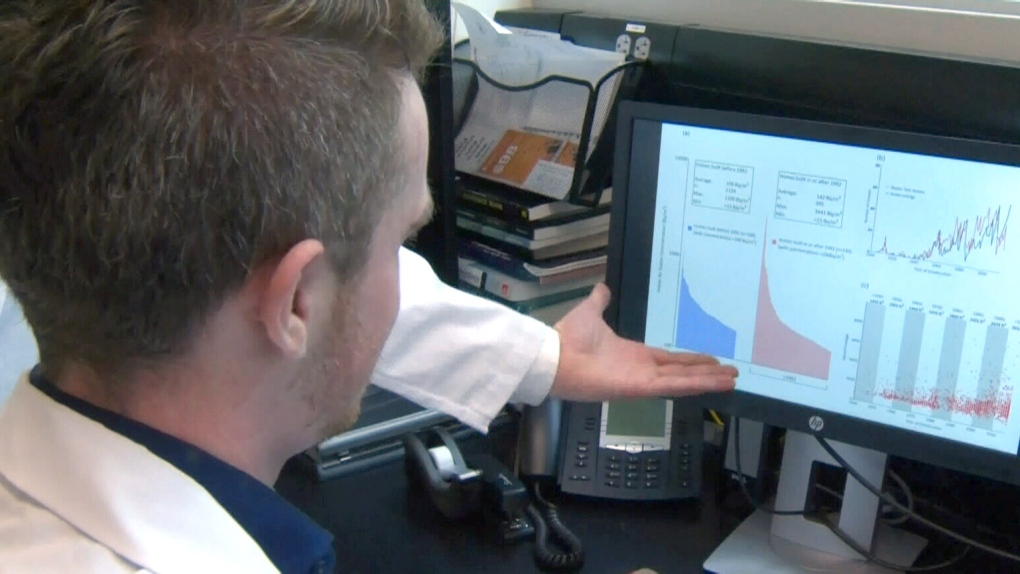Is your home safe? Experts warn odourless radioactive gas can cause lung cancer
 Health Canada is urging Canadians to check their homes for radon, a radioactive gas that occurs naturally in the ground and can leak into homes through foundation cracks or gaps around pipes. (AP Photo/Markus Schreiber)
Health Canada is urging Canadians to check their homes for radon, a radioactive gas that occurs naturally in the ground and can leak into homes through foundation cracks or gaps around pipes. (AP Photo/Markus Schreiber)
Radon is the second leading cause of lung cancer in Canada, according to Grey Bruce Public Health Unit (GBPH).
“Radon can build up in homes of any size and any age. And because you can’t see, smell, or taste radon, testing is the only way to know if this gas is in your home,” says Andrew Barton, senior public health manager at GBPH.

The health unit reminds residents that November is an ideal time of year to test for the invisible, odourless, and tasteless radioactive gas.
Health Canada even recommends that homeowners measure radon for at least three months, ideally during home-heating season.
The report goes on to say that long periods of exposure to high levels of radon in your home may lead to lung cancer, accounting for about 16 per cent of all cases annually.
GBPH unit says when radon escapes into the outdoor, it becomes diluted. But, it is known to seep into homes through cracks in the foundation.
- Download the CTV News app to get local alerts on your device
- Get the latest local updates sent to your email inbox
If you can't smell it, or see it, then you may be asking yourself how do you test for it?
The unit says there are two ways residents can test for radon indoors. They can buy a do-it-yourself radon test kit or hire a radon measurement professional to test their home.
CTVNews.ca Top Stories

W5 Investigates A 'ticking time bomb': Inside Syria's toughest prison holding accused high-ranking ISIS members
In the last of a three-part investigation, W5's Avery Haines was given rare access to a Syrian prison, where thousands of accused high-ranking ISIS members are being held.
Trudeau Liberals' two-month GST holiday bill passes the House, off to the Senate
The federal government's five-page piece of legislation to enact Prime Minister Justin Trudeau's promised two-month tax break on a range of consumer goods over the holidays passed in the House of Commons late Thursday.
Irregular sleep patterns may raise risk of heart attack and stroke, study suggests
Sleeping and waking up at different times is associated with an increased risk of heart attack and stroke, even for people who get the recommended amount of sleep, according to new research.
California man who went missing for 25 years found after sister sees his picture in the news
It’s a Thanksgiving miracle for one California family after a man who went missing in 1999 was found 25 years later when his sister saw a photo of him in an online article, authorities said.
As Australia bans social media for children, Quebec is paying close attention
As Australia moves to ban social media for children under 16, Quebec is debating whether to follow suit.
Notre Dame Cathedral: Sneak peak ahead of the reopening
After more than five years of frenetic reconstruction work, Notre Dame Cathedral showed its new self to the world Friday, with rebuilt soaring ceilings and creamy good-as-new stonework erasing somber memories of its devastating fire in 2019.
Canada Post temporarily laying off striking workers, union says
The union representing Canada Post workers says the Crown corporation has been laying off striking employees as the labour action by more than 55,000 workers approaches the two-week mark.
Can't resist Black Friday weekend deals? How to shop while staying within your budget
A budgeting expert says there are a number of ways shoppers can avoid getting enveloped by the sales frenzy and resist spending beyond their means.
Montreal shopping mall playing 'Baby Shark' song to prevent unhoused from loitering
A shopping mall and office complex in downtown Montreal is being criticized for using the popular children's song 'Baby Shark' to discourage unhoused people from loitering in its emergency exit stairwells.


































